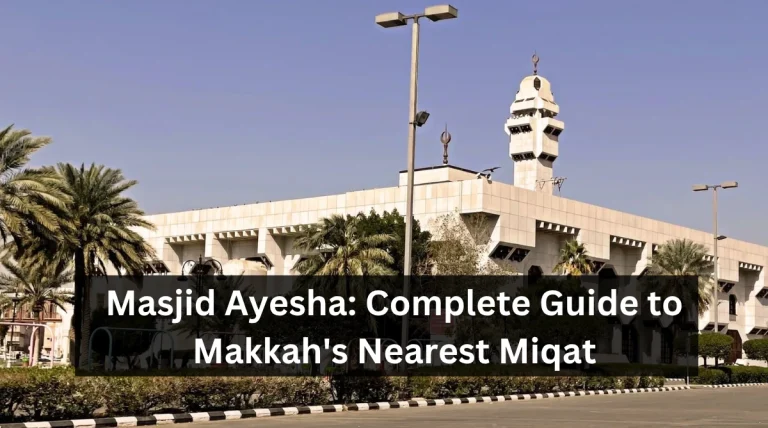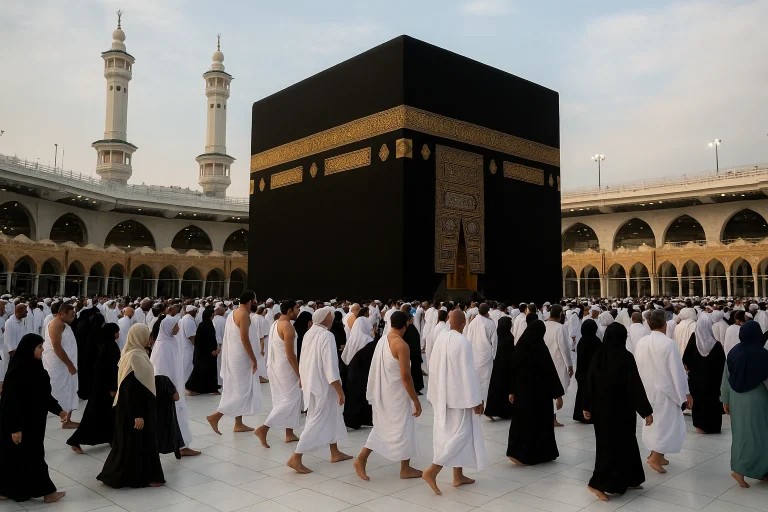Jabal Al-Nour: The Mountain of Light – History & Importance
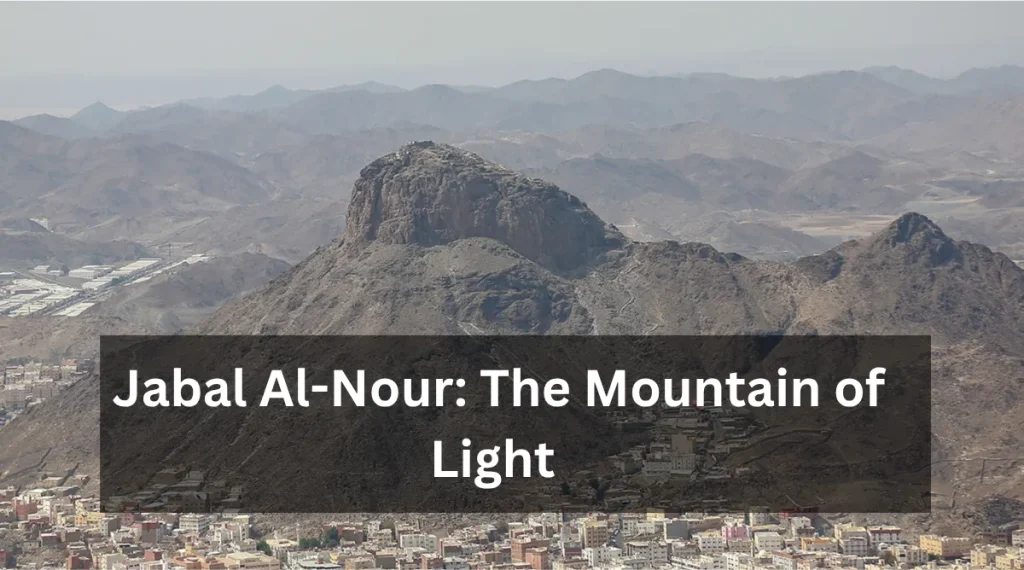
Jabal al-Nour (جبل النو), the Mountain of Light, stands as one of Islam’s most sacred landmarks. Rising majestically near Makkah, Saudi Arabia, this historic mountain houses the Cave of Hira (Ghar-e-Hira), where Prophet Muhammad (PBUH) received the first revelation of the Qur’an from the angel Jibreel (Gabriel). This divine moment marked the beginning of Islam and its eventual spread across the world.
Each year, millions of pilgrims from every corner of the globe journey to Jabal al-Nour, seeking to walk in the Prophet’s footsteps and connect deeply with Islamic history. This comprehensive guide will help you understand the significance of this sacred site and prepare for your own spiritual journey.
Location and Historical Significance
Geographical Setting
Jabal al-Nour rises approximately 5 kilometers northeast of Masjid al-Haram in Makkah, reaching an elevation of 2,100 feet (640 meters). From its summit, pilgrims are rewarded with breathtaking panoramic views of the holy city and the Grand Mosque. The mountain’s distinctive silhouette dominates the landscape, serving as a visible reminder of Islam’s origins.
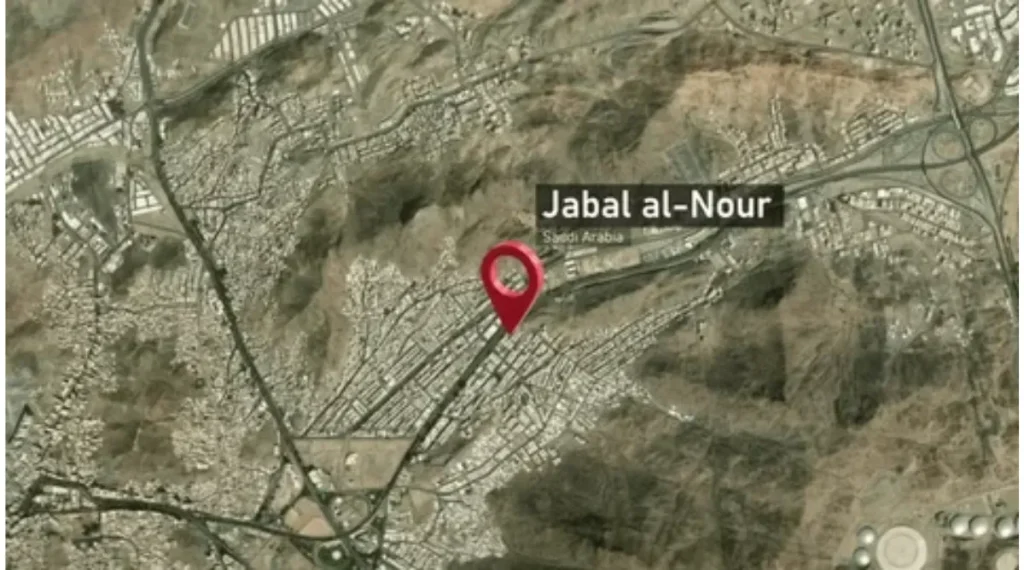
The First Revelation
At the mountain’s peak lies the Cave of Hira, the humble sanctuary where Prophet Muhammad (PBUH) received divine revelation from Jibreel (Gabriel). This profound moment in 610 CE transformed human history, as the angel delivered the first verses of what would become the Holy Qur’an:
“Read in the name of your Lord who created, created man from a clot. Read and your Lord is the most generous. Who taught by the pen, taught man that which he did not know.” (Surah Al-Alaq, 96:1-5)
A Beacon of Divine Light
The name “Mountain of Light” reflects the spiritual illumination that began with this first revelation. For Muslims worldwide, Jabal al-Nour transcends its physical form it represents the moment divine guidance began to illuminate humanity. Visiting this sacred site offers pilgrims a profound opportunity to reflect on Islam’s earliest days and honor the Prophet’s sacrifices.
The Spiritual Significance of the Climb
The Prophet’s Retreat
Long before receiving his first revelation, Prophet Muhammad (PBUH) regularly retreated to the Cave of Hira for meditation and contemplation. In these periods of solitude, he sought peace and spiritual clarity, unknowingly preparing himself for his momentous role as the final Messenger of Islam. This practice demonstrates the Prophet’s deep connection with Allah and the spiritual discipline essential to his divine mission.
A Pilgrim’s Journey
For Muslims worldwide, ascending Jabal al-Nour represents far more than physical exertion, it’s a deeply spiritual pilgrimage. As you climb, each step echoes the Prophet’s own journey, inviting reflection on his meditations, struggles, and unwavering faith. Whether you’re from Pakistan, Indonesia, Egypt, or anywhere else, this shared experience unites Muslims in a common spiritual purpose.
Unity in Faith
The pilgrimage to Jabal al-Nour transcends borders and backgrounds. Muslims from every nation climb together during Umrah or Hajj, fostering a powerful sense of global Islamic community. This unity strengthens collective faith and reminds pilgrims of the universal brotherhood that defines Islam.
Your Climbing Guide: Practical Steps
| Aspect | Details |
| Total Steps | 1,200 steps leading to the summit of Jabal al-Nour. |
| Estimated Climb Duration | 1 to 3 hours, depending on your pace and physical condition. |
| Climbing Difficulty | Moderately difficult – the path is steep and narrow in parts. |
| Best Time to Climb | Early morning or late evening to avoid the heat. Night climbs are possible with a flashlight. |
| Required Items | Water, flashlight (if climbing at night), comfortable shoes, snacks like dates or energy bars. |
| Resting Spots | Available along the path for short breaks during the climb. |
| Spiritual Significance | The site where Prophet Muhammad (PBUH) received the first revelation from Jibreel (Gabriel). |
| Weather Conditions | Hot during the day, best to avoid climbing in the midday sun. |
Optimal Timing
Plan your ascent for early morning or late evening to avoid the intense desert heat. While nighttime climbs are popular, be aware that the path lacks lighting. If climbing after dark, a reliable flashlight is essential for safe navigation.
The Ascent
The journey to the summit involves approximately 1,200 steps leading to the Cave of Hira. The path is steep and narrow in places, with the complete climb taking 1 to 3 hours depending on your fitness level and rest frequency. Remember: this is a spiritual journey, not a race. Take your time and absorb the significance of each step.
Essential Climbing Tips
- Hydration is crucial: Bring ample water, especially during warmer hours
- Footwear matters: Wear sturdy shoes with excellent grip for the rocky, sometimes steep terrain
- Rest mindfully: Utilize the designated resting spots along the route to catch your breath and reflect
- Pace yourself: Listen to your body and climb at a comfortable rhythm
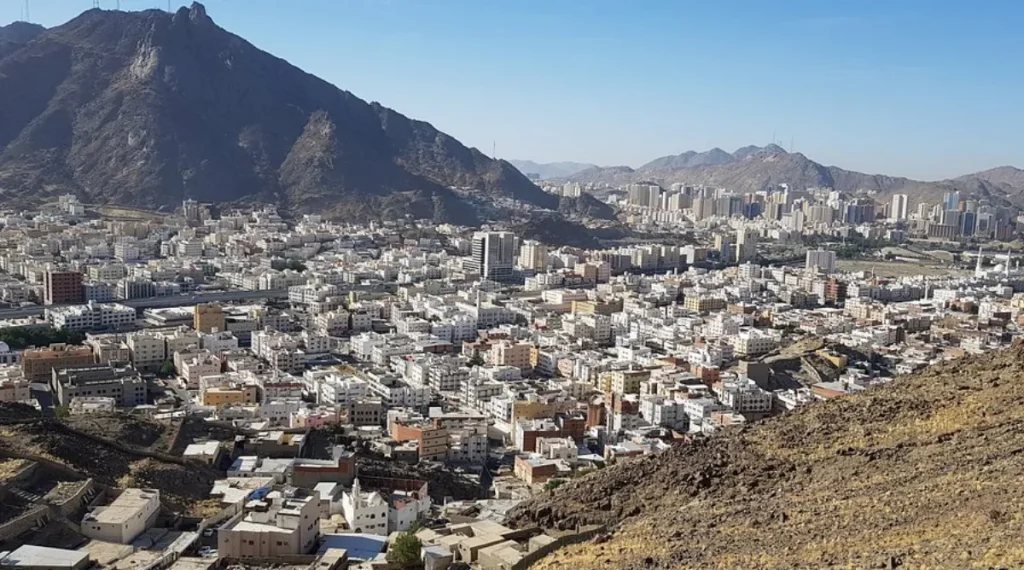
What to Pack and How to Prepare
Must-Bring Items
Water: Carry more than you think you’ll need—dehydration happens quickly in the desert climate
Flashlight: Essential for early morning or evening climbs when natural light is limited
Proper Footwear: Invest in comfortable, supportive shoes with non-slip soles designed for rocky surfaces
Clothing Recommendations
Choose light, breathable fabrics that allow air circulation and keep you cool during the climb. Your clothing should be modest and appropriate for a sacred site while providing comfort for physical activity.
Sun Protection
The desert sun is unforgiving. Pack sunscreen, a wide-brimmed hat, and consider bringing a light scarf or cloth for additional protection. Rehydrate regularly throughout your journey.
Travel and Accommodation Information
Visa Requirements
International pilgrims need a valid Saudi Arabian visa for Umrah or Hajj. Requirements vary by nationality, so consult your nearest Saudi consulate or authorized travel agency well in advance of your planned visit for current regulations and processing times.
Where to Stay
Makkah offers diverse accommodation options near Masjid al-Haram, ranging from economical lodgings to luxury Makkah hotels. Staying close to the Grand Mosque provides convenient access to the Holy Kaaba and allows for rest between visits to significant sites like Jabal al-Nour.
Getting to Jabal al-Nour
Taxis are the most common transportation option, with fares typically ranging from 25 to 30 Saudi Riyals. During Hajj season, expect higher demand and possible delays. Ensure your driver takes you as close to the mountain base as possible, though traffic restrictions may apply during peak pilgrimage periods.
Deepening Your Spiritual Connection
Embrace Reflection
As you ascend Jabal al-Nour, allow yourself moments of contemplation. Consider the Prophet’s journey, his sacrifices, and the immense faith required to fulfill his divine mission. This climb offers a unique opportunity for self-examination and spiritual growth, mirroring the Prophet’s own path toward revelation.
A Universal Bond
Pilgrims from every continent share this sacred experience. The climb creates a profound connection among believers, regardless of origin or background. Whether from Turkey, Pakistan, Indonesia, or Egypt, all who ascend Jabal al-Nour join in a timeless spiritual tradition that strengthens faith and Islamic unity.
Frequently Asked Questions
What does “Jabal al-Nour” mean?
“Jabal al-Nour” translates to “Mountain of Light,” reflecting the divine illumination that began with the first Qur’anic revelation. The mountain houses the Cave of Hira and stands at 2,100 feet elevation, offering pilgrims a place of meditation, reflection, and profound spiritual significance as they connect with the origins of Islam.
Where exactly is Jabal al-Nour located?
Jabal al-Nour sits approximately 5 kilometers northeast of Masjid al-Haram in Makkah, Saudi Arabia. At an elevation of roughly 2,100 feet (640 meters), it offers spectacular views of the holy city and the Grand Mosque.
How long does the climb take?
Most pilgrims complete the climb in 1 to 3 hours, depending on fitness level, rest breaks, and climbing conditions. The route consists of approximately 1,200 steps up steep, sometimes challenging terrain. Early morning or late evening climbs help avoid extreme heat and can make the journey more comfortable.
What makes Jabal al-Nour historically significant?
Jabal al-Nour is the site where Prophet Muhammad (PBUH) received the first revelation from angel Jibreel (Gabriel) in the Cave of Hira. This momentous event occurred in 610 CE and marked the beginning of the Prophet’s mission to spread Islam. The first verses of the Qur’an were revealed at this location, making it one of Islam’s most sacred sites.
Conclusion: A Journey That Transforms
Jabal al-Nour is far more than a geographic landmark—it stands as a spiritual milestone for every Muslim. The journey to the Cave of Hira embodies the Prophet Muhammad’s sacrifices and honors the divine wisdom that began with Islam’s first revelation. Whether you visit during Hajj, Umrah, or as part of your personal spiritual journey, climbing Jabal al-Nour offers a life-changing experience that deepens your faith and connection to Islam’s sacred roots.

